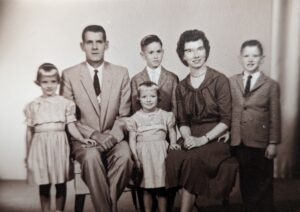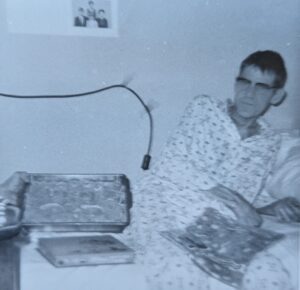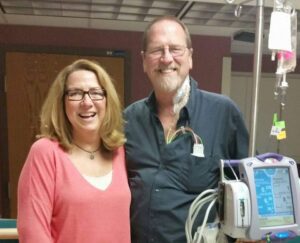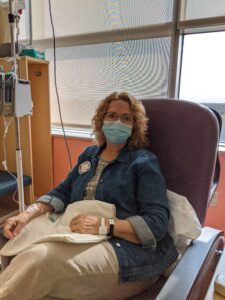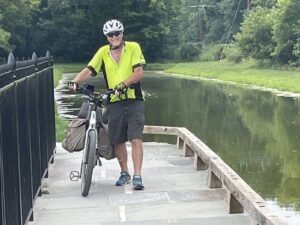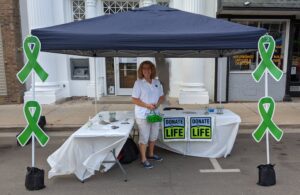Written by Diane Wilkie
My hATTR story began in the mid-1960’s when my father, a healthy, strong, outdoorsy guy in his late 40’s started tripping, experiencing numbness, and having dizzy spells. It took my mom quite some time and frustration to get him to seek medical attention, and once he did the family doctor was stumped. Specialists were consulted, tests were run, and finally, after much trial and error, Dad was diagnosed with amyloidosis in 1967. Doctors at University of Michigan told us that it was incredibly rare and that they had only diagnosed a handful of patients at the time. The disease was affecting his nerves and there was nothing they could do about it.
As the disease progressed, he was unable to feel his feet and could no longer walk. He had lost most of the feeling in his hands but could still grip utensils if they had large handles. He became bed-ridden and moved to a skilled-nursing facility. Eventually he could no longer sit up without passing out. He died on November 22, 1970, at age 54. I was 13 years old.
Fast-forward to 2012. My brother Doug mentioned that he was having shortness of breath when he played basketball, biked, or participated in other activities that were part of his everyday life. His doctor ran some tests and said everything looked fine. Maybe he just needed to slow down a bit. He was 59, healthy and strong. He didn’t accept that he needed to slow down so he sought other opinions. It took a while, but someone finally noticed the amyloidosis in his family history and suggested it might be that. We had no idea that amyloidosis could affect people in ways other than our dad experienced, or that it could be inherited. Wow. Genetic testing was ordered in 2013. He was positive for the mutation.
My sister, Deb, and I then both went for genetic testing. Meanwhile, Doug found that Mayo Clinic in Rochester, Minnesota had a team that studied our disease. He went there for a week of tests and consultations which confirmed hATTR amyloidosis with cardiac involvement. While there was no cure for it, they were having success with liver transplants. By removing the liver that over-produces the TTR protein and replacing it with a normal liver they could slow the progression of the disease. Great news. Scary, but let’s do it. More tests, more consults.
I received a phone call from my genetic counselor on January 10, 2014 – my 38th wedding anniversary. The results were positive. My husband, Alan, and I were vacationing in Florida and had just come in from the pool when we got the news. We were stunned. We sat on our tiny hotel balcony and cried. Then Alan said, “I guess we’ll be calling Mayo when we get home.” I made the call from my office the next Monday. I said, “I’m Doug’s sister and my genetic testing was positive. What should I do?” They said, “Come next week.” We repacked our Florida suitcases to Minnesota attire and off we went. I should mention here that I worked for a company with excellent vacation and sick time policies, and I had accrued time enough to take off without losing any pay. Alan was already retired, so it was a bonus that he could go anywhere with me, at any time.
My first appointment at Mayo was with hematology on January 28th, 2014. I underwent the same tests and consults that Doug had been through. I was so fortunate to have a big brother who shared every bit of information along his journey, because it meant I was never blind-sided or surprised by anything the doctors said! So many times I remember a doctor or technician asking if I had any questions and my response would be, “No, Doug already told me.”
After these initial tests were run, I met with one of the cardiologists on the team. My notes from that appointment read, “All testing is normal. Blood tests for amyloid normal, fat aspirate normal. Echo – pumping well. Slight increase in thickness of wall, but lots of things can cause that. EKG low voltage – suspicious, not in keeping w/thickening. Could do an MRI but wouldn’t be conclusive. Heart biopsy only way to know for sure if thickening is amyloid.”
The doctors had already decided I should return in three months for repeat tests and would consider doing a heart biopsy at that time. I asked why not do the heart biopsy now? They agreed and off I went for a biopsy the next morning.
Back at work the following Monday I received a call from Mayo. All five samples taken during the biopsy were positive for amyloid. There was no longer a question that the disease was active, even though I had no outward symptoms. My team agreed that we should assume it would be aggressive because of my family history. Next steps: meet with a liver transplant team and investigate the possibly of getting into a clinical trial. I was 56 years old, healthy and strong. I had no symptoms of any illness, and I was going to have a liver transplant. You can’t make this stuff up.
Doug and I spent a of time on the phone during this period. One day he asked, “you know that questionnaire you have to fill out all the time that asks how you would rate your overall life? What do you rate it?” I told him I always used to put a 10, the highest rating, because my life is pretty darn good. Now I put a 9. He said he did the same and that his wife would get mad at him because life wasn’t so good right then. But he and I both agreed that it could be a lot worse. We were getting the right help at the right place, and we were going to be fine. We were determined that we would not lie in a bed and die slowly like Dad did.
My next trip to Mayo was in early March for a transplant evaluation. Labs, consults with surgeon, psych, dietician, financial, etc. My notebook was crammed with notes, information leaflets, and business cards. Whew!
Our April visit included a transplant class, where we learned everything we never wanted to know about how the transplant would be done and what to expect after. The other people in the class were all so sick I felt like an imposter. They were all suffering from horrible liver diseases, many were quite jaundiced, and some very bloated. I looked like a normal, healthy person. Ugh. That will sure make you count your blessings!
More tests, vaccinations, health insurance consults, short- and long-term disability discussions with my employer, contracts with a flight service who could get me to Mayo within a 6-hour window, house keys to friends who would take care of our cat while we were gone, housing arranged in Rochester for post-transplant stay, preliminary packing, medical supplies purchased – and on July 7th I was placed on the transplant waiting list! Now to hurry up and wait: keep my phone with me at all times, stay within a certain distance of home, avoid getting sick, and go to work every day like everything is normal. Looking back, I have no idea how we did this!
Another trip to Mayo in September to repeat tests and update my MELD score and exceptions. These numbers were important to get me to the top of the transplant list! Back home to wait some more.
On November 14, 2014 I received a call from my transplant surgeon just before 1 am. They had a liver for me! We jumped out of bed and called the flight service to get a plane ready. Alan and I flew into Rochester where a taxi was waiting at the airport to take us to the hospital. We had been told what doors to go to and what to say and were immediately whisked to an employee elevator to take us to the liver transplant unit. Things happened very quickly then, until they didn’t. Labs, x-rays, flu swab, were all done very quickly. The surgeon let us know that the donor organ would be coming from another hospital and I would have my surgery by evening.
An aside here – during the transplant conversations with my team I was asked if I would donate my liver to someone else. This is called a domino transplant. Since my liver, technically, was healthy (it just over produced this otherwise normal little protein), someone else who met the criteria for receiving an “amyloid liver” could accept it. A gentleman who was critically ill received my liver that night. We met later in the liver unit and I visit him every year when we go to Mayo for our annual checkups!
The transplant was a success, I had an easy recovery, and I was back to work in a few months. I continue taking immunosuppressants and Diflunisal (to help slow the progression of the amyloidosis). I return to Mayo every November for tests and consults. In 2020 I started experiencing some tingling and numbness in my left foot, which has progressed at a slow rate. Nerve testing and biopsies confirm it to be amyloid-related. In 2022 I started Patisiran infusions every three weeks. This was a relatively new drug that was showing success at stopping or slowing neuropathy specifically caused by amyloidosis.
By now I had been happily retired for a few years, so spending a half-day at the infusion center was not a problem. Alan and I took card games, magazines, and my knitting along to pass the time. The infusion itself took 80 minutes, but oh, those pre-meds! was given Tylenol and then an IV hit of Benadryl that made me feel like I hit a wall. This was followed by a giant dose of steroids into the IV which gave me the heebie-jeebies and a horrible pins and needles feeling in places you don’t want to know about! An hour later, and finally, the infusion itself. I would come home exhausted but unable to rest, craving every carb imaginable, and in an emotional turmoil. But the drug was working! I had more feeling in my foot! We shall soldier on.
Also in 2022 my calcium levels were off, which led to a parathyroidectomy. Fairly common and routine and unrelated to the hATTR amyloidosis. However, during that surgery my heart decided to drop to an unhealthy rate and go out of rhythm- several times. Seems the amyloid was now affecting the electrical system within my heart so that the top part of my heart was not communicating correctly with the bottom to keep an even rhythm. Within a couple of days, I found myself back in surgery having a pacemaker implanted. A few months later the pacemaker readings confirmed that I now have atrial fibrillation. Along with the pacemaker I take blood thinners to keep the blood flowing nicely. So far, so good.
2023 brought me a new drug – Amvuttra. It does the same thing the Patisiran does, but in an injection every 12 weeks- and no pre-meds! So far it seems to be helping. I still have numbness and tingling, but it doesn’t seem to be getting worse.
Whatever happened to my brother, Doug, you may wonder? The doctors determined that while he was definitely a candidate for a liver transplant for the hATTR, his heart had already been damaged so much that they weren’t sure it could survive the transplant. This meant he would need a heart-liver transplant. He went into the hospital on support in January 2015 and received his new organs on September 30th that year. He has made an astounding recovery and is active and healthy. He enjoys riding his e-bike every chance he gets.
My sister, Deb, meanwhile, didn’t show any signs of the disease for many years, so we assumed she was a carrier only. In 2018 she experienced chest pain and had a new echocardiogram done that showed some thickening of the heart wall. She was able to get into a study for Tafamadis, which has since been FDA approved, and she continues with that treatment.
Our children have all been tested for hATTR amyloidosis. My only child tested negative, so my line stops with me. Half my nieces and nephews are negative, and half positive. Those who tested positive are followed by the team at Mayo Clinic. Some are already taking Tafamadis. Some are experiencing symptoms such as carpal tunnel, which we now know to be a precursor.
We are all healthy and happy. We share information among ourselves. I guess you could say we’re our own hATTR support group.
We have cousins who have hATTR amyloidosis, so we know my dad’s sister was a carrier. We don’t know if his other sister was a carrier, but we know that neither she nor her children never experienced outward symptoms. They are all deceased now, so there’s no way to know. My dad’s father died in his late 50’s after some period of time with what the family called “heart trouble.” We can only assume he had hATTR. Beyond that I don’t know the cause of death of his parents, although they lived into what I would call old age at the time.
While hATTR amyloidosis is a significant condition that needs monitoring, medication, and sometimes major surgery, we are grateful to be living in a time of such medical progress, in which both effective medications and complex surgeries are available. We urge everyone who has a family history to get genetic testing early. This condition is autosomal dominant, so every child has a 50/50 chance of inheriting it. You may find that you are clear. Or if you find you do have hATTR, while you are still strong and healthy, you can take action to give yourself the best quality of life. You can live a full and happy life!

